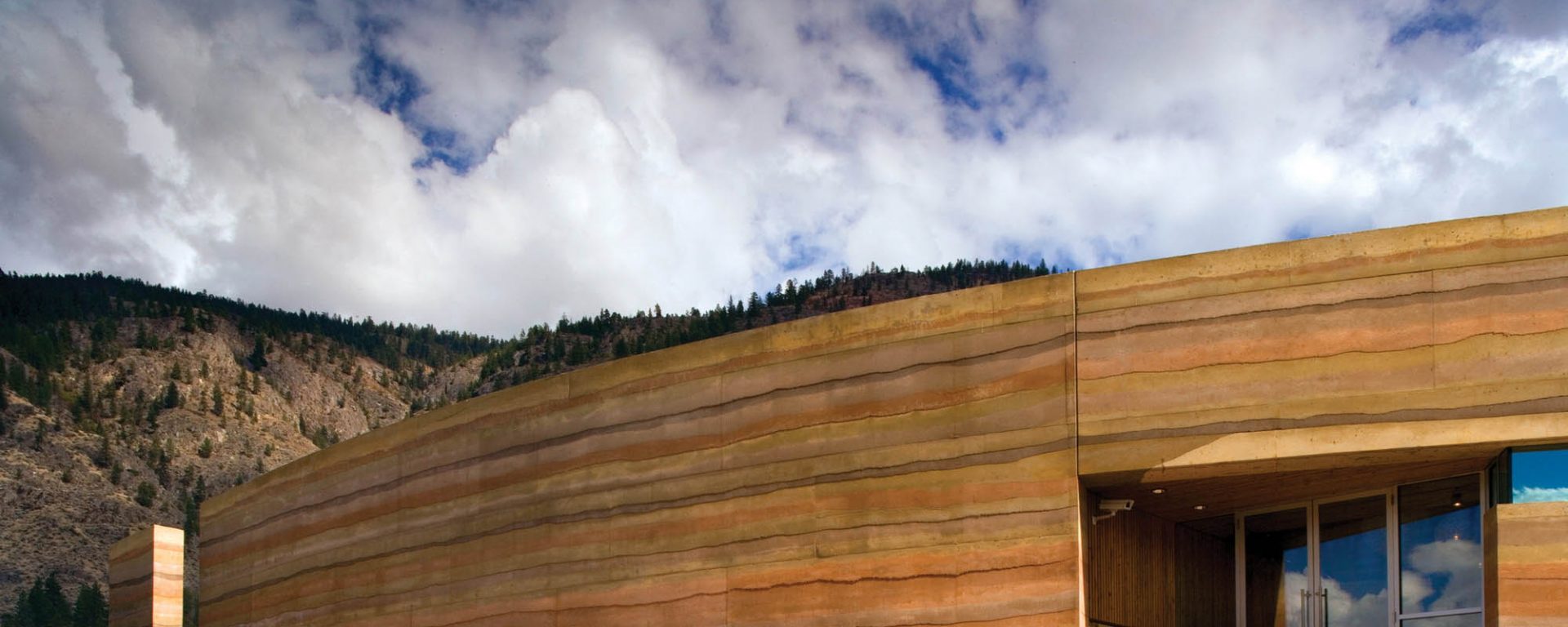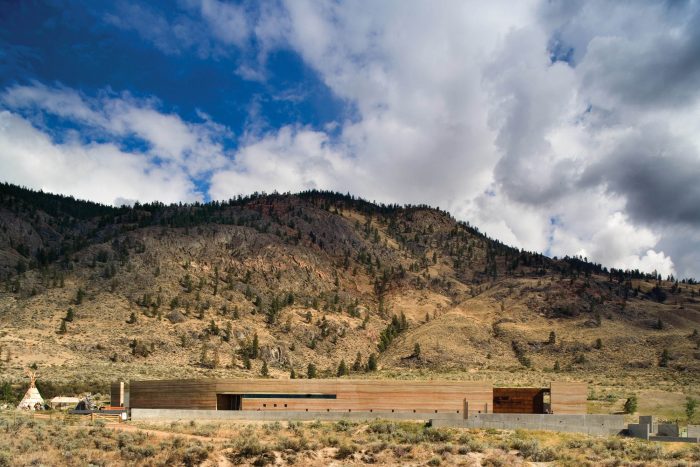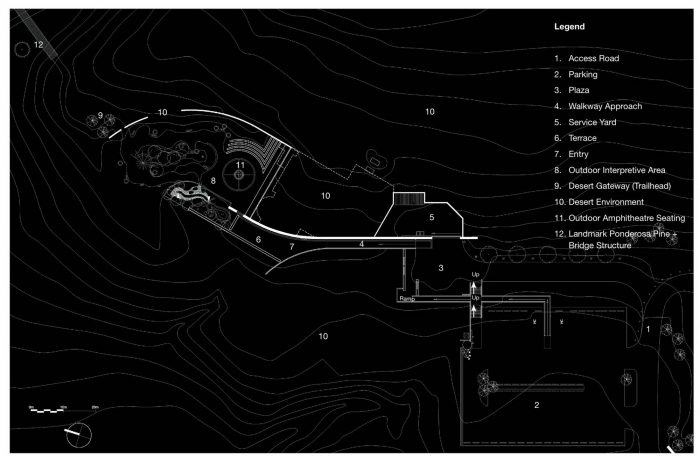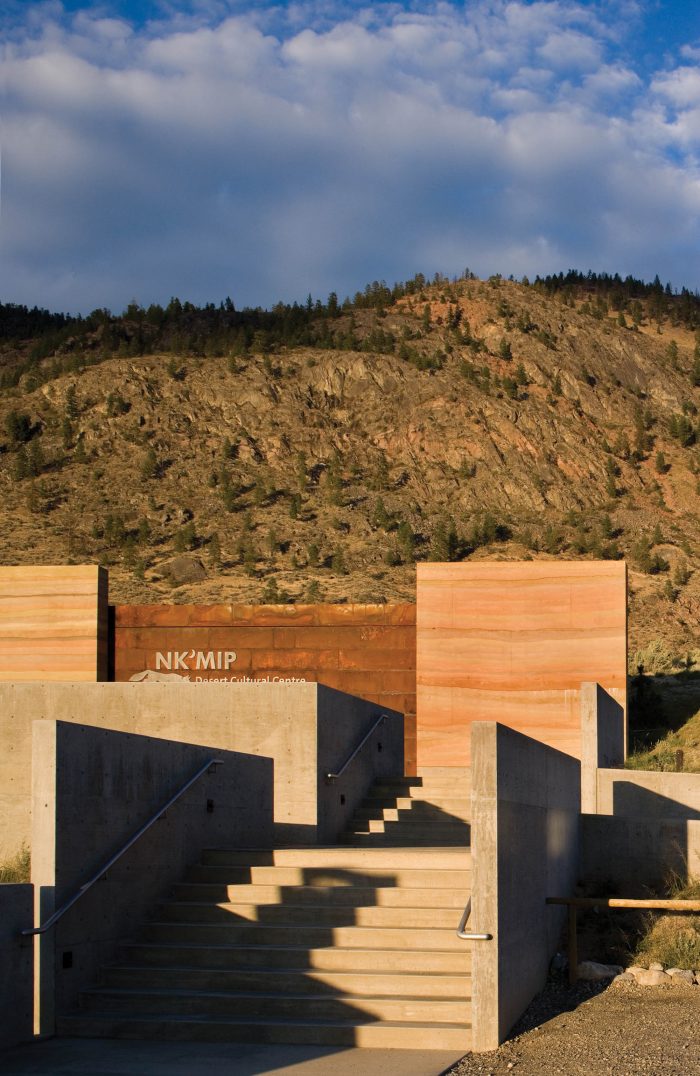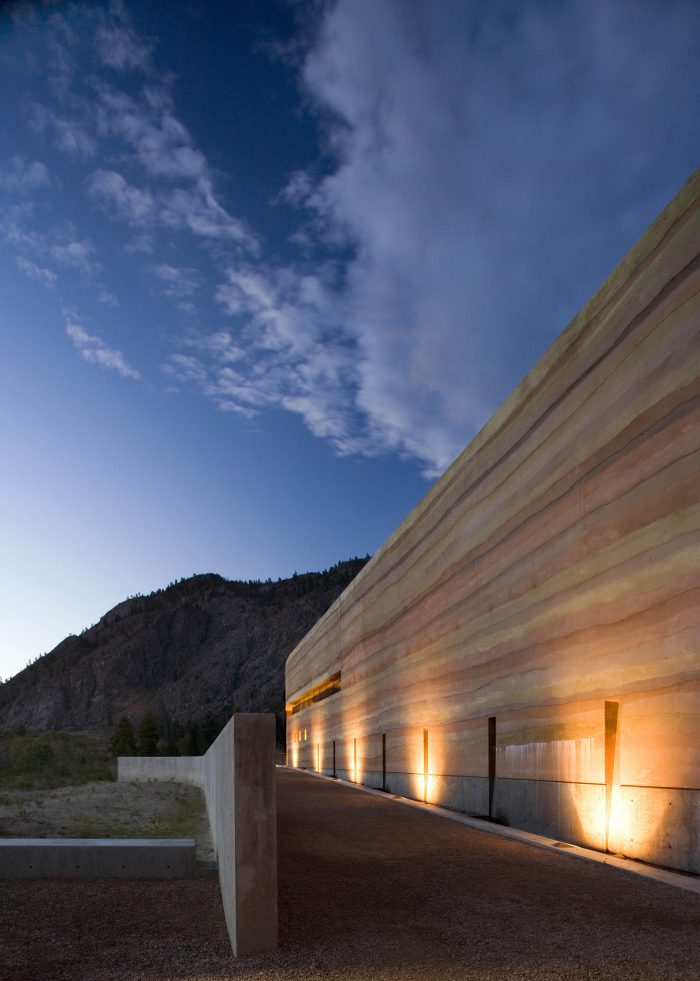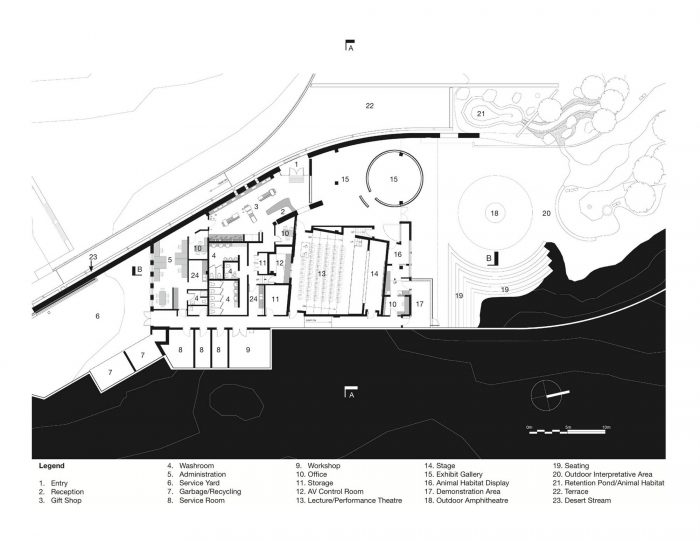Nk’Mip沙漠文化中心的设计是对建筑的独特环境–不列颠哥伦比亚省Osoyoos的南Okanagan山谷中发现的不寻常的加拿大沙漠–做出的具体和可持续的反应。这个解释中心毗邻大盆地沙漠的遗迹(约有1600英亩的土地被乐队作为保护区保存下来),是一个更大的200英亩总体规划的一部分。
The Nk’Mip Desert Cultural Centre is designed to be a specific and sustainable response to the building’s unique context—the unusual Canadian desert found in the South Okanagan Valley in Osoyoos, British Columbia. Sited adjacent to a remnant of the Great Basin Desert (approximately 1,600 acres are being preserved by the band as a conservation area), this interpretative centre is part of a larger 200-acre master plan.
Nk’Mip 是不列颠哥伦比亚省众多新的原住民中心中的第一个,也是探索建筑的表现潜力以传达原住民文化丰富的过去和不断变化的未来这一日益增长的趋势的一部分。这种建筑探索背后的实际原因来自于省领导层–总理为改善原住民关系所做的努力导致了条约程序的改变–以及管理保留地上允许的建筑类型的监管环境的转变。
Nk’Mip is the first of a number of new B.C. aboriginal centres, and part of a growing trend to explore the expressive potential of architecture to convey the rich past and the transforming future of aboriginal culture. The practical reasons behind this architectural exploration grow out of provincial leadership—a premier whose efforts to improve aboriginal relations have resulted in changes to the treaty process—as well as a shift in the regulatory environment governing the types of buildings permitted on reserve land.
该建筑设有室内和室外展览,颂扬了乐队的文化和历史,其设计是对这一重要地点的延伸,并反映了乐队作为土地管理者的作用。沙漠景观流过建筑的绿色屋顶,被夯实的土墙挡住。部分被淹没的建筑的位置非常特别,以使游客的视线从西边的奥索约斯的侵蚀性开发中集中出来,墙的高度被设定为创造出一个层次分明的视野,沙漠在中间地带升起,退到邻近的河岸景观,以及远处的山脉。
The building features indoor and outdoor exhibits that celebrate the culture and the history of the band, and is designed to be an extension of the remarkable site, and reflects the band’s role as stewards of the land. The desert landscape flows over the building’s green roof, held back by a rammed earth wall. The partially submerged building is sited very specifically to focus the visitor’s eye away from the encroaching development of Osoyoos to the west, with the height of the wall set to create a layered view of the desert rising up in the middle ground, receding to the riparian landscape adjacent, and the mountains in the distance.
从停车场出发的减弱入口序列,使游客穿过一系列嵌套的混凝土墙,直至夯土墙尽头的入口广场。广场用于收集大型团体和当天活动的标志牌,沿着低矮的混凝土墙,将原始的沙漠景观和建筑分开。这条路线由水渠进一步界定,吸引人们走向入口,经过服务庭和行政通道的角钢门。进入解释中心的入口位于缓缓的弧形墙的中点。
The attenuated entry sequence from the parking area moves visitors through a series of nested concrete walls up to an entry plaza at the end of the rammed earth wall. The plaza—used for collecting large groups, and signage about events of the day—leads along a low concrete wall that separates the original desert landscape and the building. This route is further defined by channel of water that draws people towards the entry, past the cor-ten steel gate of the service court and administration access. Entry into the interpretive centre occurs at the midpoint of the gently arcing wall.
在中心内部,一个剧场和 “黑匣子 “展览空间展示了有关乐队的信息及其与土地的历史关系。位于展览空间中心的圆形 “坑道 “让人联想到围着火堆对话的体验。从这里开始,参观者穿过一面玻璃墙,进入外部展览空间,这里有关于本地种植的信息,一个户外表演区和露天剧场,一个帐篷,一个大型雕塑,以及一个蛇类研究区示范空间。这个区域也是一个步道起点,可以沿着50公里长的小路在沙漠中进行有导游和无导游的步行。小型的解释亭、重建的坑道房屋和解释雕塑组成的村庄点缀着这些小径。
Inside, a theatre and “black box” exhibition space present information about the band and its historical relationship with the land. The round volume of the “pit house” at the centre of the exhibition space invokes the experience of conversation around a fire. From here, visitors move through a glazed wall into exterior exhibit space featuring information on native planting, an outdoor performance area and amphitheatre, a tule mat teepee, a large figural sculpture, and a snake research area demonstration space. This area also serves as a trailhead for guided and unguided walks along 50 kilometres of paths through the desert. Small interpretive pavilions and a village of reconstructed pit houses and interpretive sculptures punctuate these trails.
可持续发展的特点
Nk’Mip沙漠文化中心位于加拿大最壮观和最濒危的景观之一。其罕见的沙漠状况是美洲大沙漠的最北端,向南延伸至墨西哥的索诺兰沙漠。这块土地是加拿大这一独特栖息地最大的完整遗迹。它是奥索尤斯印第安人部落土地的一部分。这个部落也属于更大的Okanagan Nation,它一直延伸到美国(Okanagan代表了一个更广泛的地理区域,这些部落与独立的组成部落共享共同的语言)。
Sustainability Features
The Nk’Mip Desert Cultural Centre is located in one of the most spectacular and endangered landscapes in Canada. Its rare desert condition is the northernmost tip of the Great American Desert, which extends southward as far as the Sonoran Desert in Mexico. This parcel of land is the largest intact remnant of this unique habitat in Canada. It is part of the land of the Osoyoos Indian Band. This band also belongs to the larger Okanagan Nation which extends down into the US (the Okanagan represents a broader geographic area of bands sharing common language with separate constituent bands).
项目对深层可持续发展的关注源于这一景观的脆弱性,也反映了乐队的核心价值和历史。极端的气候使可持续设计成为一个非常特殊的挑战。炎热干燥的夏季和凉爽干燥的冬季,平均气温从-18度到+33度不等,夏日的气温常常达到+40。该建筑的选址和朝向是实现可持续发展的第一个战略举措:部分埋入地下的结构缓解了极端的温度,其朝向优化了被动式太阳能的性能,南面和西面的玻璃最小化。该项目在可持续设计方面的雄心勃勃还包括以下特点。北美最大的夯土墙。
The project’s concern with deep sustainability grows out of the fragility of this landscape, and reflects the core values and history of the band. The extreme climate made sustainable design a very particular challenge. Hot, dry summers and cool, dry winters see average temperatures ranging from –18 degrees to +33 degrees and often reaching +40 on summer days. The building’s siting and orientation are the first strategic moves toward sustainability: the partially buried structure mitigates the extremes in temperature, and its orientation optimizes passive solar performance, with glazing minimized on the south and west sides. The project’s ambitious approach towards sustainable design also includes the following features: The largest rammed earth wall in North America.
长80米、高5.5米、厚600毫米的隔热墙(R33)能够稳定温度变化。它由当地的土壤与混凝土和颜色添加剂混合而成,在冬季保暖,在夏季其巨大的热质量为建筑降温–就像周围的土壤对地下室的影响一样。最近不列颠哥伦比亚省松树甲虫的侵袭导致了蓝斑松的过剩,这里的蓝斑松被用于室内和室外的应用。虽然蓝染色松是一种当地材料,通常不指定用于成品建筑,但Nk’Mip是一个示范项目,展示了它如何在室内和室外使用,以庆祝其独特的视觉品质,正如它的名字所暗示的那样,这种木材有一个蓝色的色调,就像应用了蓝色的洗涤,而不是典型的黄色更典型的松木。虽然其固有的结构品质相当,但强大的日本国际市场的喜好在历史上影响了对黄(白)松的需求。
At 80m long, 5.5m high, and 600mm thick, this insulated wall (R33) stabilizes temperature variations. Constructed from local soils mixed with concrete and colour additives, it retains warmth in the winter, its substantial thermal mass cooling the building in the summer—much like the effect the surrounding earth has on a basement. A recent infestation of pine beetles in British Columbia has led to an excess of bluestain pine, which here is used in interior and exterior applications. Although bluestain pine is a local material not normally specified for finished building use, Nk’Mip is something of a demonstration project, showing how it can be used both inside and outdoors to celebrate its unique visual qualities As its name suggests, the wood has a blue-tinted cast as though a blue wash has been applied, rather than the typical yellow colour more typical of pine. Although its inherent structural qualities are equivalent, the preferences of the powerful Japanese international market have historically influenced demand for yellow (white) pine.
可居住的绿化屋顶。这种可居住的景观屋顶减少了建筑对景观的视觉印记,并使更大比例的沙漠景观栖息地在场地上重新建立(补植使用本土物种)。屋顶还能进一步稳定温度和保温。
机械功能。
天花板和楼板的板内辐射冷却和加热创造了一个均匀、舒适的环境,避免了空气、噪音和灰尘的爆炸。再加上100%的室外空气置换通风,该系统将比强制通风系统节省30-50%的费用。
A habitable green roof. This habitable landscaped roof reduces the building’s visual imprint on the landscape, and allows a greater percentage of the desert landscape habitat to be re-established on the site (replanting uses indigenous species). The roof also provides further temperature stabilization and insulation.
Mechanical features:
In-slab radiant cooling and heating in both ceiling and floor slabs create an even, comfortable environment that avoids blasts of air, noise and dust. Coupled with 100% outdoor air displacement ventilation, the system will result in savings of 30 to 50% over a forced air system.
濒危物种研究
该建筑计划包括用于乐队获奖的响尾蛇研究项目的设施,以及公共观赏区,游客可以看到濒临灭绝的响尾蛇被捕获,标记和芯片,以便进一步研究和保护。
谨慎的用水管理
在沙漠中,水是珍贵的,在入口处沿着夯土墙的备用水渠引入了这一主题。不太明显的是,通过采用低流量水龙头、无水小便器和双冲水马桶,工地给水井的需求减少了40%。
Endangered species research
The building program includes facilities for the band’s award-winning rattlesnake research project, as well as public viewing areas where visitors can see endangered rattlesnakes captured, tagged and microchipped for further study and protection.
Careful water use management
Water is precious in the desert, and a spare channel of water at the entrance along the rammed earth wall introduces this theme. Less visibly, demand on the site fed well is reduced by 40% by incorporating low-flow faucets, waterless urinals, and dual flush toilets.
建筑师:DIALOG
面积:1115 m²
年份:2006年
摄影:Nic Lehoux Photography
项目组:Norm Hotson, Stephanie Forsythe, Tina Hubert, Julie Bogdanowicz
结构工程:Equilibrium Consulting Inc.
景观设计:Phillips Farevaag Smallenberg
机械工程:Cobalt Engineering
电气工程:MCL Engineering
代码:LMDG Code Consultants
展览设计:Aldrich Pears Associates
声学:BKL Consulting
舞台设计:Douglas Welch
剧院电气:Acumen Consulting Engineers
现场展示:Bufo Incorporated, Harry Parsons
零售:Retail Excellence, Natalie Tan
总承包商:Greyback Construction
夯土墙分包商:Terra Firma Builders Ltd.
建筑师负责人:Bruce Haden
项目建筑师:Brady Dunlop
城市:Osoyoos
国家:加拿大
Architects: DIALOG
Area: 1115 m²
Year: 2006
Photographs: Nic Lehoux Photography
Project Team:Norm Hotson, Stephanie Forsythe, Tina Hubert, Julie Bogdanowicz
Structural Engineering:Equilibrium Consulting Inc.
Landscape Architecture:Phillips Farevaag Smallenberg
Mechanical Engineering:Cobalt Engineering
Electrical Engineering:MCL Engineering
Code:LMDG Code Consultants
Exhibit Design:Aldrich Pears Associates
Acoustic:BKL Consulting
Theatre Design:Douglas Welch
Theatre Electrical:Acumen Consulting Engineers
Live Displays:Bufo Incorporated, Harry Parsons
Retail:Retail Excellence, Natalie Tan
General Contractor:Greyback Construction
Rammed Earth Wall Sub Contractor:Terra Firma Builders Ltd.
Architect In Charge:Bruce Haden
Project Architect:Brady Dunlop
City:Osoyoos
Country:Canada

